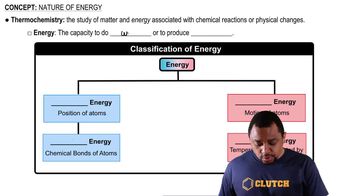Palmitic acid (C16H32O2) is a dietary fat found in beef and butter. The caloric content of palmitic acid is typical of fats in general. Which dietary substance (sugar or fat) contains more Calories per gram? The standard enthalpy of formation of palmitic acid is -208 kJ/mol and that of sucrose is -2226.1 kJ/mol. [Use H2O(l) in the balanced chemical equations because the metabolism of these compounds produces liquid water.]
Ch.6 - Thermochemistry
Chapter 6, Problem 106c
Hydrogen and methanol have both been proposed as alternatives to hydrocarbon fuels. How does the energy of these fuels compare to that of octane (C8H18)?
 Verified step by step guidance
Verified step by step guidance1
Identify the chemical reactions for the combustion of hydrogen, methanol, and octane. For example, the combustion of octane is: \[ 2 \text{C}_8\text{H}_{18} + 25 \text{O}_2 \rightarrow 16 \text{CO}_2 + 18 \text{H}_2\text{O} \]
Determine the standard enthalpy change (\( \Delta H^\circ \)) for each combustion reaction using standard enthalpies of formation from a data table. The formula is: \[ \Delta H^\circ = \sum \Delta H^\circ_f(\text{products}) - \sum \Delta H^\circ_f(\text{reactants}) \]
Calculate the energy released per mole of fuel for each reaction. This involves using the \( \Delta H^\circ \) values obtained in the previous step.
Convert the energy released per mole to energy released per gram or per liter, if necessary, to make a fair comparison between the fuels.
Compare the energy values obtained for hydrogen, methanol, and octane to determine which fuel releases more energy per unit mass or volume.

Verified Solution
Video duration:
16mWas this helpful?
Key Concepts
Here are the essential concepts you must grasp in order to answer the question correctly.
Energy Content of Fuels
The energy content of a fuel, often measured in joules or calories per gram, indicates how much energy can be released during combustion. Hydrocarbon fuels like octane have high energy densities due to their molecular structure, which allows for significant energy release when carbon-hydrogen bonds are broken. Understanding the energy content is crucial for comparing the efficiency and viability of alternative fuels like hydrogen and methanol.
Recommended video:
Guided course

Nature of Energy
Combustion Reactions
Combustion reactions involve the chemical reaction of a fuel with oxygen, producing heat, light, and combustion products such as carbon dioxide and water. The type of fuel affects the products and the amount of energy released. For instance, hydrogen combustion produces only water, while methanol and octane produce carbon dioxide, which has implications for environmental impact and energy efficiency.
Recommended video:
Guided course

Combustion Apparatus
Alternative Fuels
Alternative fuels, such as hydrogen and methanol, are considered for their potential to reduce reliance on traditional fossil fuels and lower greenhouse gas emissions. Hydrogen is noted for its high energy content and clean combustion, while methanol is easier to store and transport. Evaluating these alternatives against octane involves analyzing their energy outputs, environmental effects, and practicality for widespread use.
Recommended video:
Guided course

Phenyl Group
Related Practice
Textbook Question
823
views
Open Question
Hydrogen and methanol have both been proposed as alternatives to hydrocarbon fuels. Use standard enthalpies of formation to calculate the amount of heat released per kilogram of methanol fuel and per kilogram of hydrogen fuel.
Textbook Question
Hydrogen and methanol have both been proposed as alternatives to hydrocarbon fuels. Which fuel contains the most energy in the least mass?
602
views
Open Question
Derive a relationship between ΔH and ΔE for a process in which the temperature of a fixed amount of an ideal gas changes.
Textbook Question
Under certain nonstandard conditions, oxidation by O2(g) of 1 mol of SO2(g) to SO3(g) absorbs 89.5 kJ. The enthalpy of formation of SO3(g) is –204.2 kJ under these conditions. Find the enthalpy of formation of SO2(g).
3258
views
Open Question
One tablespoon of peanut butter has a mass of 16 g. It is combusted in a calorimeter whose heat capacity is 120.0 kJ/°C. The temperature of the calorimeter rises from 22.2 °C to 25.4 °C. Find the food caloric content of peanut butter.
